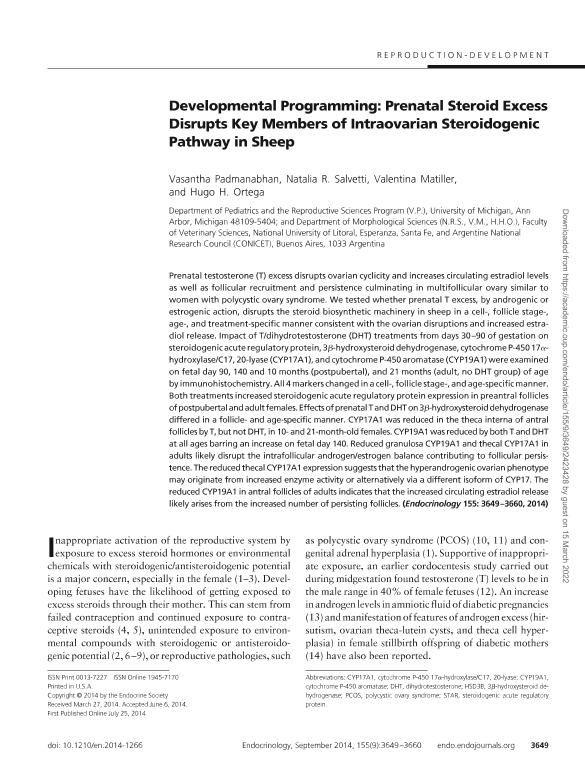Artículo
Developmental programming: prenatal steroid excess disrupts key members of intra-ovarian steroidogenic pathway in sheep
Fecha de publicación:
08/2014
Editorial:
Oxford University Press
Revista:
Endocrinology
ISSN:
0013-7227
e-ISSN:
1945-7170
Idioma:
Inglés
Tipo de recurso:
Artículo publicado
Clasificación temática:
Resumen
Prenatal testosterone (T) excess disrupts ovarian cyclicity and increases circulating estradiol levels as well as follicular recruitment and persistence culminating in multifollicular ovary similar to women with polycystic ovary syndrome. We tested whether prenatal T excess, by androgenic or estrogenic action, disrupts the steroid biosynthetic machinery in sheep in a cell-, follicle stage-, age-, and treatment-specific manner consistent with the ovarian disruptions and increased estradiol release. Impact of T/dihydrotestosterone (DHT) treatments from days 30?90 of gestation on steroidogenic acute regulatory protein, 3-hydroxysteroid dehydrogenase, cytochrome P-450 17-hydroxylase/C17, 20-lyase (CYP17A1), and CYP19A1 were examined on fetal day 90, 140 and 10 months (postpubertal), and 21 months (adult, no DHT group) of age by immunohistochemistry. All<br />4 markers changed in a cell-, follicle stage-, and age-specific manner. Both treatments increased steroidogenic acute regulatory protein expression in preantral follicles of postpubertal and adult females. Effects of prenatal T and DHT on 3-hydroxysteroid dehydrogenase differed in a follicleand age-specific manner. CYP17A1 was reduced in the theca interna of antral follicles by T, but not DHT, in 10- and 21-month-old females. CYP19A1 was reduced by both T and DHT at all ages barring an increase on fetal day 140. Reduced granulosa CYP19A1 and thecal CYP17A1 in adults likely disrupt the intrafollicular androgen/estrogen balance contributing to follicular persistence. The<br />reduced thecal CYP17A1 expression suggests that the hyperandrogenic ovarian phenotype may originate from increased enzyme activity or alternatively via a different isoform of CYP17. The reduced CYP19A1 in antral follicles of adults indicates that the increased circulating estradiol release likely arises from the increased number of persisting follicles.
Archivos asociados
Licencia
Identificadores
Colecciones
Articulos(ICIVET-LITORAL)
Articulos de INST. DE CIENCIAS VETERINARIAS DEL LITORAL
Articulos de INST. DE CIENCIAS VETERINARIAS DEL LITORAL
Citación
Padmanabhan, Vasantha; Salvetti, Natalia Raquel; Matiller, Valentina; Ortega, Hugo Hector; Developmental programming: prenatal steroid excess disrupts key members of intra-ovarian steroidogenic pathway in sheep; Oxford University Press; Endocrinology; 155; 9; 8-2014; 3649-3660
Compartir
Altmétricas




